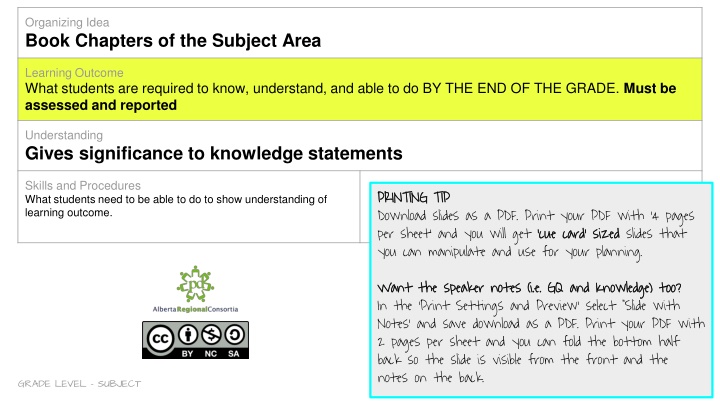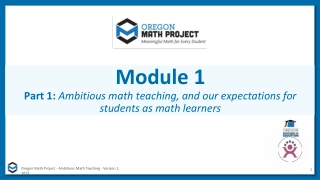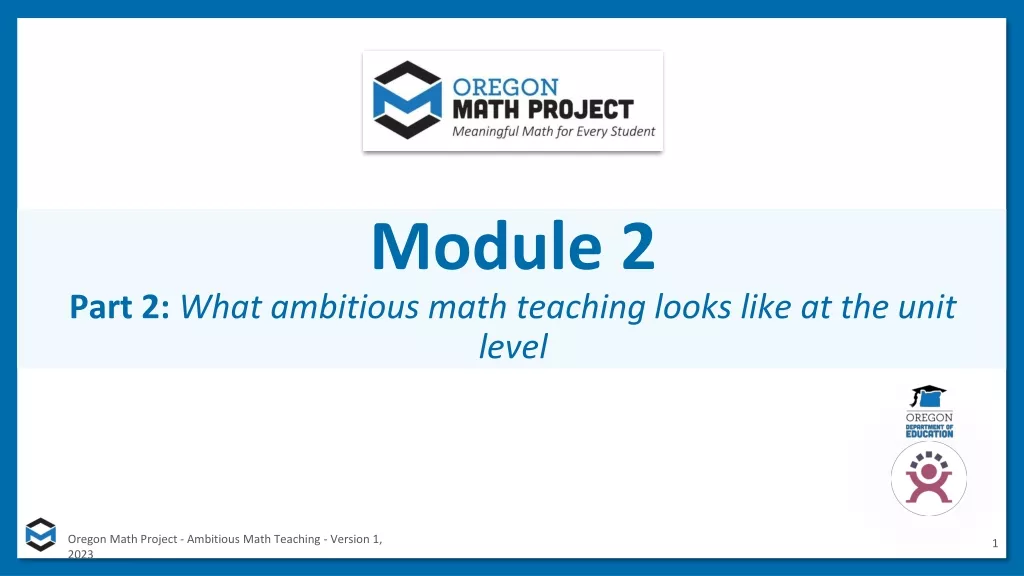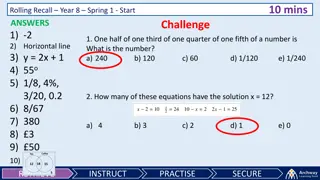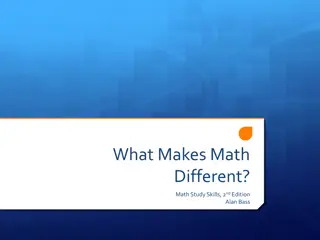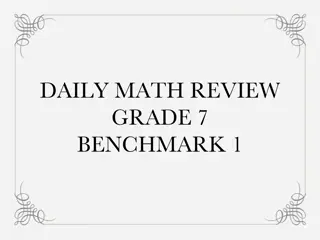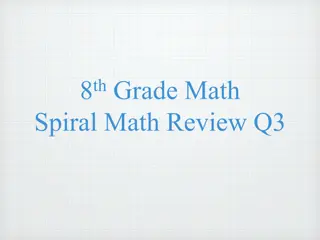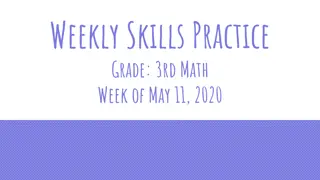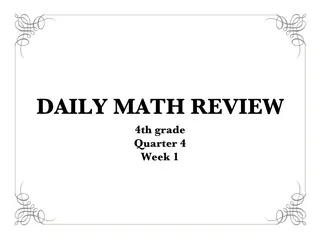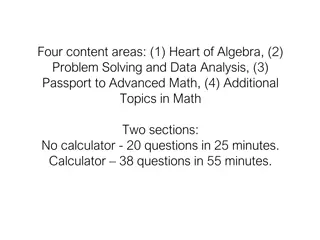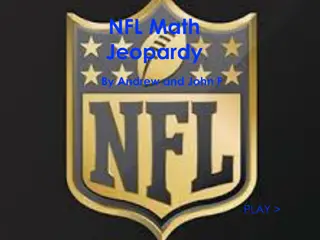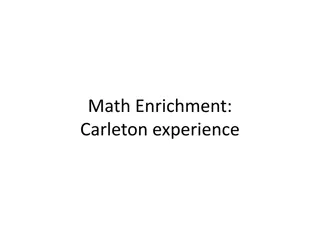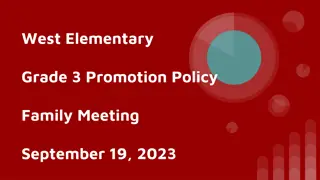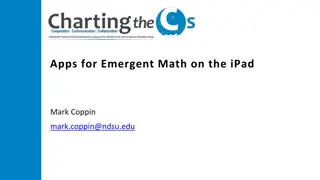Grade Three Math Learning Outcomes
Key learning outcomes for grade three math, covering place value interpretation, addition/subtraction strategies, and multiplication/division techniques. Students will develop skills to identify place values, use standard algorithms for calculations, and relate multiplication to repeated addition. The content emphasizes understanding the base-10 system, estimating sums, modeling regrouping, and more.
Download Presentation

Please find below an Image/Link to download the presentation.
The content on the website is provided AS IS for your information and personal use only. It may not be sold, licensed, or shared on other websites without obtaining consent from the author.If you encounter any issues during the download, it is possible that the publisher has removed the file from their server.
You are allowed to download the files provided on this website for personal or commercial use, subject to the condition that they are used lawfully. All files are the property of their respective owners.
The content on the website is provided AS IS for your information and personal use only. It may not be sold, licensed, or shared on other websites without obtaining consent from the author.
E N D
Presentation Transcript
Organizing Idea Book Chapters of the Subject Area Learning Outcome What students are required to know, understand, and able to do BY THE END OF THE GRADE. Must be assessed and reported Understanding Gives significance to knowledge statements Skills and Procedures What students need to be able to do to show understanding of learning outcome. PRINTING TIP Download slides as a PDF. Print your PDF with 4 pages per sheet and you will get cue card sized you can manipulate and use for your planning. PRINTING TIP cue card sized slides that Want the speaker notes (i.e. GQ and Knowledge) too? In the Print Settings and Preview select Slide with Notes and save download as a PDF. Print your PDF with 2 pages per sheet and you can fold the bottom half back so the slide is visible from the front and the notes on the back. Want the speaker notes (i.e. GQ and Knowledge) too? UPDATED APRIL 2022 GRADE LEVEL - SUBJECT
Organizing Idea Number Learning Outcome Students interpret place value within 100 000. Understanding Place value is the basis for the base-10 system. Place value determines the value of a digit based on its place in a number relative to the ones place. Place value is used to read, write, and compare numbers. Compare and order natural numbers. Skills and Procedures Identify the place value of each digit in a natural number. Express the relationship between two numbers using <, > , or = . Relate the values of adjacent places. Count and represent the value of a collection of nickels, dimes, and quarters as cents. Determine the value of each digit in a natural number. Count and represent the value of a collection of loonies, toonies, and bills as dollars. Express natural numbers using words and numerals. Express various compositions of a natural number using place value. Recognize French and English symbolic representations of monetary values. Round natural numbers to various places. UPDATED APRIL 2022 GRADE THREE- MATH
Organizing Idea Number Learning Outcome Students apply strategies for addition and subtraction within 1000. Understanding Addition and subtraction strategies can be chosen based on the nature of the numbers. Standard algorithms for addition and subtraction may be used for any natural numbers. Add and subtract natural numbers using standard algorithms. Skills and Procedures Relate strategies for the addition and subtraction of two-digit numbers to strategies for the addition and subtraction of three-digit numbers. Estimate sums and differences. Solve problems using addition and subtraction. Model regrouping by place value for addition and subtraction. Explain the standard algorithms for addition and subtraction of natural numbers. UPDATED APRIL 2022 GRADE THREE- MATH
Organizing Idea Number Learning Outcome Students analyze and apply strategies for multiplication and division within 100. Understanding Quantities can be composed and decomposed through multiplication and division. Model a quotient by partitioning a quantity into equal groups or groups of a certain size, with or without remainders. Skills and Procedures Compose a product using equal groups of objects. Visualize and model products and quotients as arrays. Relate multiplication to repeated addition. Recognize interpretations of multiplication and division in various contexts. Relate multiplication to skip counting. Investigate multiplication by 0. UPDATED APRIL 2022 GRADE THREE- MATH
Organizing Idea Number Learning Outcome Students analyze and apply strategies for multiplication and division within 100. Understanding Sharing and grouping situations can be interpreted as multiplication or division. Multiplication and division strategies can be supported by addition and subtraction. Express multiplication and division symbolically. Skills and Procedures Investigate multiplication and division strategies. Explain the meaning of the remainder in various situations. Multiply and divide within 100. Solve problems using multiplication and division in sharing or grouping situations. Verify a product or quotient using inverse operations. Determine a missing quantity in a product or quotient in a variety of ways. UPDATED APRIL 2022 GRADE THREE- MATH
Organizing Idea Number Learning Outcome Students analyze and apply strategies for multiplication and division within 100. Understanding Multiplication number facts have related division facts. Skills and Procedures Examine patterns in multiplication and division, including patterns in multiplication tables and skip counting. Recognize families of related multiplication and division number facts. Recall multiplication number facts, with factors to 10, and related division facts. UPDATED APRIL 2022 GRADE THREE- MATH
Organizing Idea Number Learning Outcome Students interpret fractions in relation to one whole. Understanding Fractions are numbers between natural numbers. Fractions can represent part-to-whole relationships. A unit fraction describes the size of the equal parts of a fraction. The size of the parts and the total number of equal parts in the whole are inversely related. Relate various representations of the same fraction, limited to denominators of 12 or less. Skills and Procedures Model fractions of a whole quantity, length, shape, or object, in various ways, limited to denominators of 12 or less. Compare the same fraction of different-sized wholes. Visualize fractions as compositions of a unit fraction. Compare different fractions of the same whole that have the same denominator. Identify the numerator and denominator of a fraction in various representations. Compare different fractions of the same whole that have the same numerator and different denominators. Name a given fraction. Express the relationship between two fractions of the same whole, using < , >, or =. Express fractions, including one whole, symbolically, limited to denominators of 12 or less. Relate a fraction less than one to its position on the number line, limited to denominators of 12 or less. Compare fractions to benchmarks of 0,1/2 , and 1. GRADE THREE- MATH UPDATED APRIL 2022
Organizing Idea Algebra Learning Outcome Students illustrate equality with equations. Understanding Two expressions are equal if they represent the same number. Skills and Procedures Write equations that represent equality between a number and an expression or between two different expressions of the same number. UPDATED APRIL 2022 GRADE THREE- MATH
Organizing Idea Algebra Learning Outcome Equations can include unknown values. Understanding Two expressions are equal if they represent the same number. Skills and Procedures Model equations that include an unknown value, including with a balance. Determine an unknown value on the left or right side of an equation, limited to equations with one operation. Solve problems using equations, limited to equations with one operation. UPDATED APRIL 2022 GRADE THREE- MATH
Organizing Idea Geometry Learning Outcome Students relate geometric properties to shape. Understanding Geometric properties are relationships between geometric attributes. Geometric properties define a class of polygon. Skills and Procedures Investigate the relationships between the sides of a polygon, including perpendicular, parallel, and equal, using referents for 90 or by measuring. Sort polygons according to geometric properties and describe the sorting rule. Classify polygons as regular or irregular using geometric properties. Investigate the relationships between vertices of a polygon, including equal or right angles, using direct comparison or referents for 90 . Describe geometric properties of regular and irregular polygons. UPDATED APRIL 2022 GRADE THREE- MATH
Organizing Idea Geometry Learning Outcome Students relate geometric properties to shape. Understanding Geometric properties do not change when a polygon undergoes a transformation. Skills and Procedures Examine geometric properties of polygons by translating, rotating, or reflecting using hands-on materials or digital applications UPDATED APRIL 2022 GRADE THREE- MATH
Organizing Idea Measurement Learning Outcome Students determine length using standard units. Understanding Length is measured in standard units according to the metric system and the imperial system. Length can be expressed in various units according to context and desired precision. Recognize length expressed in metric or imperial units. Skills and Procedures Relate millimetres, centimetres, and metres. Relate inches to feet and yards. Approximate a measurement in inches, feet, or yards using centimetres or metres. Justify the choice of millimetres, centimetres, or metres to measure various lengths. Measure lengths of straight lines and curves, with millimetres, centimetres, or metres. UPDATED APRIL 2022 GRADE THREE- MATH
Organizing Idea Measurement Learning Outcome Students determine length using standard units. Understanding Length remains the same when decomposed or rearranged. Skills and Procedures Determine the perimeter of polygons. Determine the length of an unknown side given the perimeter of a polygon. UPDATED APRIL 2022 GRADE THREE- MATH
Organizing Idea Measurement Learning Outcome Students determine length using standard units. Understanding Length can be estimated when less accuracy is required. Skills and Procedures Identify referents for a centimetre and a metre. Estimate length by comparing to a benchmark. Estimate length by visualizing the iteration of a referent for a centimetre or metre. UPDATED APRIL 2022 GRADE THREE- MATH
Organizing Idea Measurement Learning Outcome Students interpret angles. Understanding An angle is the union of two arms with a common vertex. An angle can be interpreted as the motion of a length rotated about a vertex. Skills and Procedures Recognize various angles in surroundings. Recognize situations in which an angle can be perceived as motion. UPDATED APRIL 2022 GRADE THREE- MATH
Organizing Idea Measurement Learning Outcome Students interpret angles. Understanding Two angles can be compared directly or indirectly. Skills and Procedures Compare two angles directly by superimposing. Compare two angles indirectly by superimposing a third angle. Estimate which of two angles is greater. Identify referents for 90 . Identify 90 angles in the environment using a referent. UPDATED APRIL 2022 GRADE THREE- MATH
Organizing Idea Patterns Learning Outcome Students analyze patterns in numerical sequences. Understanding A sequence is a list of terms arranged in a certain order. Sequences may be finite or infinite. Skills and Procedures Recognize familiar numerical sequences, including the sequence of even or odd numbers. Describe position in a sequence using ordinal numbers. Differentiate between finite and infinite sequences. UPDATED APRIL 2022 GRADE THREE- MATH
Organizing Idea Patterns Learning Outcome Students analyze patterns in numerical sequences. Understanding A sequence can progress according to a pattern. Skills and Procedures Recognize skip-counting sequences in various representations, including rows or columns of a multiplication table. Determine any missing term in a skip-counting sequence using multiplication. Describe the change from term to term in a numerical sequence using mathematical operations. UPDATED APRIL 2022 GRADE THREE- MATH
Organizing Idea Time Learning Outcome Students tell time using clocks. Understanding Clocks are standard measuring tools used to communicate time. Skills and Procedures Investigate relationships between seconds, minutes, and hours using an analog clock. Relate minutes past the hour to minutes until the next hour. Describe time of day as a.m. or p.m. relative to 12-hour cycles of day and night. Tell time using analog and digital clocks. Express time of day in relation to one 24-hour cycle. UPDATED APRIL 2022 GRADE THREE- MATH
Organizing Idea Statistics Learning Outcome Students interpret and explain representations of data. Understanding Representation connects data to a statistical question. Skills and Procedures Formulate statistical questions for investigation. Predict the answer to a statistical question. UPDATED APRIL 2022 GRADE THREE- MATH
Organizing Idea Statistics Learning Outcome Students interpret and explain representations of data. Understanding Representation expresses data specific to a unique time and place. Representation tells a story about data. Skills and Procedures Collect data using digital or non-digital tools and resources. Examine First Nations, M tis, or Inuit representations of data. Consider possible answers to a statistical question based on the data collected. Represent first-hand and second-hand data in a dot plot or bar graph with one-to-one correspondence. Describe the story that a representation tells about a collection of data in relation to a statistical question. UPDATED APRIL 2022 GRADE THREE- MATH
